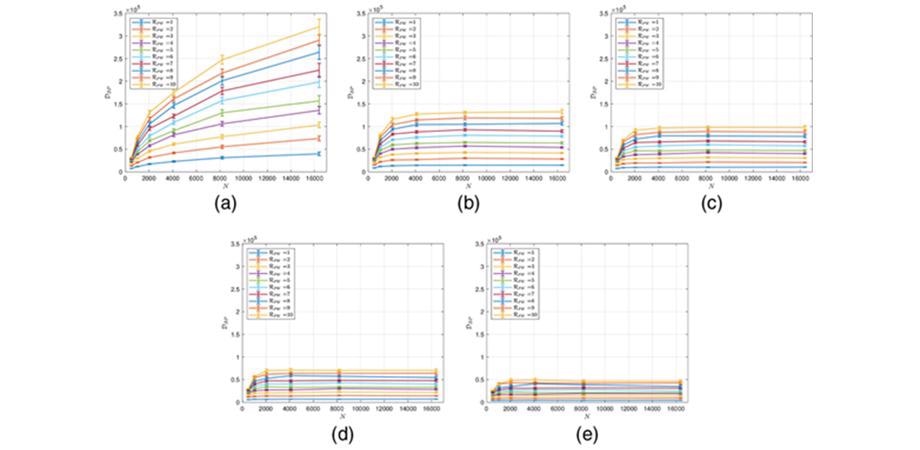Why do stars appear to “twinkle” in the night sky? The interaction of light with various layers of the Earth’s atmosphere causes these rapid and seemingly random changes in the color and brightness of the stars. Different volumes of air can move very differently relative to each other during turbulence. As a result, two light beams traveling through turbulence on even slightly different paths are affected very differently.
 Branch point density (DBP) versus grid resolution (N) for different inner scales of turbulence. Contrary to expectations, the branch point density does not grow indefinitely but instead tapers off as the grid resolution increases, provided the effects of a non-zero inner scale is considered. Image Credit: Beck et al.
Branch point density (DBP) versus grid resolution (N) for different inner scales of turbulence. Contrary to expectations, the branch point density does not grow indefinitely but instead tapers off as the grid resolution increases, provided the effects of a non-zero inner scale is considered. Image Credit: Beck et al.
The phenomenon of twinkling, or “scintillation,” is important in many optics-related fields, including astronomy and laser-based communications. Strong scintillation effects cause light beams to intrude constructively and destructively with one another at certain points in the receiver’s pupil when they propagate through a deeply turbulent medium.
The Achilles’ heel of Adaptive Optics (AO) systems is the so-called “branch points,” which are prominent distortions in the measured phase of the received light. In AO, deformable mirrors are used to suspend out the expected distortion in incoming light before it occurs. Unfortunately, practical mirrors are incapable of compensating for the abrupt phase shifts that take place near and at branch points.
Studying the effects of branch points in detail using wave-optics simulations is one way to overcome the problems they cause. However, the branch-point problem is multifaceted. Numerous parameters must be taken into account to generate reliable and realistic results
One of the primary goals of the current research published in Optical Engineering was to achieve this. A team of researchers headed by Dr. Jeffrey R. Beck of Michigan Technological University in the United States conducted the research.
The researchers looked at how grid sampling, or the simulation’s resolution, affects the number of observable branch points in a wave-optics simulation. They also wanted to learn more about the effects of a non-zero inner turbulence scale on simulation results.
Simply put, the “inner scale” is the smallest size below which eddies (swirling fluids and the reverse current produced in a turbulent flow) in a turbulent medium start to dissipate due to friction caused by fluid-molecule collisions.
Hundreds of wave propagation simulations were run under a multitude of turbulence conditions, and the number and distribution of branch points diversified as each parameter was changed. Researchers discovered that, contrary to expectations, the density of branch points did not increase indefinitely as the grid resolution increased.
While it was previously thought that the branch-point density increased inexorably with increasing resolution, the current study found that this was not the case.
Our results show that without considering the effects of a non-zero inner scale, the branch point density indeed grows without bound. However, as the size of the inner scale increases, this unbounded growth decreases under stronger turbulence conditions and ultimately tapers off—or ‘saturates’—for sufficiently high grid resolutions.
Dr Jeffrey R. Beck, Michigan Technological University
This groundbreaking discovery could pave the way for more reliable wave-optics simulations of the energy distribution in a turbulent volume.
Overall, the current research sheds light on the complex problem of branch points in AO systems and may aid researchers in improving wave-optics simulations and models.
The results shown in our paper are encouraging from the standpoint that they could readily improve the performance of existing branch-point-tolerant phase reconstruction algorithms used in AO, as well as pave the way to future developments.
Dr Jeffrey R. Beck, Michigan Technological University
In astronomy and laser-based communications, discovering efficient strategies to tame branch points will mitigate the impact of turbulence. As a result, researchers may be able to better perform and interpret experiments without the bothersome scintillation artifacts.
Journal Reference:
Beck, J. R., et al. (2022) Wave-optics investigation of branch-point density. Optical Engineering. doi.org/10.1117/1.OE.61.4.044104.